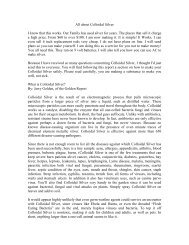Building a Stone Retaining Wall – 7pages - Jubilee101
Building a Stone Retaining Wall – 7pages - Jubilee101
Building a Stone Retaining Wall – 7pages - Jubilee101
Create successful ePaper yourself
Turn your PDF publications into a flip-book with our unique Google optimized e-Paper software.
<strong>Building</strong> a<strong>Stone</strong> <strong>Retaining</strong>When we design and build a stone retaining wall, ourgoal isn’t merely to change grade or hold back an embankment;we also aim to enhance the landscape. The retainingwall shown on these pages, for instance, which we built arounda new in-ground swimming pool, provides seating and helpsdefine a roomlike space in the backyard. The wall was necessarybecause of the slope of the yard, but locating it between the pooland the house gave us the opportunity to create a landscapedesign as beautiful as it is practical.Like the majority of the stone walls and fences we build, thisone was installed “dry,” which means that no mortar was used.And while it isn’t exceptionally tall, stone retaining walls can bevirtually any height (though a practical limit is about 8 feet); builtright, they will last almost forever — or at least until the bulldozerscome and redevelop the site.On the other hand, if improperly built, even a low wall canquickly collapse into a pile of rock. What follows are the techniqueswe use to make retaining walls last as long as the stonethey’re built from.Native <strong>Stone</strong> Is BestWhile it’s possible to build a stone retaining wall out of practicallyany type of rock, we prefer to use native stone. There aretwo reasons for this: A native stone will look like it belongs in<strong>Wall</strong>by Bruce ZaretskyFully settled subsoils,a well-compacted base ofcrushed stone, and gooddrainage are essentialfor long-lasting resultsthe landscape, and shipping costs will be significantly less.Here in the Northeast, we can choose from a number ofstones, including Pennsylvania bluestone, limestone, andfieldstone; all can be found within a five-hour truck drive andare available in various shapes, sizes, and colors.To keep the cutting and fitting in check, we like to use stonewith a flat bottom and a clean face. That way, all we need to dois dress the front of the stone with a hammer (to make it lookMARCH 2006 I JLC I 1
<strong>Building</strong> a <strong>Stone</strong> <strong>Retaining</strong> <strong>Wall</strong>hand-cut) and set it, which creates lesswaste and saves on labor and materialscost. Most sedimentary stones availablein our part of the Northeast, includinglimestone and the sandstones (such asbluestone), fit this bill.Of course, each variety of stone worksdifferently, and some need to be workedwith a hammer more than others for agood fit. Some stone masons lay up wallswithout ever picking up a hammer;others — using special stone hammersand chisels — cut every stone.I’m somewhere in between; I allowthe site and the stone to tell me whichapproach works best. In certain cases, awall will fit the site better visually if thestone is left in its natural state; othertimes, a more refined and worked stonelooks better.To build this particular wall, we useda Pennsylvania flagstone called Colonial<strong>Wall</strong> <strong>Stone</strong>. It’s actually a quarrying byproductthat would probably be discardedif not for its excellent qualities asa drywall-building stone. We buy it bythe ton, paying about $150 to $200 perton delivered; each pallet is filled withstones with (we hope) at least one flatface. The stones fit together quickly withlittle cutting, which allows us to worknot only artistically but efficiently.On a good day, an experienced wallerand helper can hand-cut and fit abouttwo tons, or roughly 25 to 30 face squarefeet (measured on the finished face ofthe wall).Accounting for ExistingSoil ConditionsBecause we do much of our work in newconstruction, where cuts and fills arecommon, we need to determine whereexcavation has taken place to prevent ourwalls from moving or settling aftercompletion.We’ve found that freeze/thaw cycles doa good job of settling disturbed subsoils,so as a rule of thumb we insist on waitingat least one winter before building on anynew-construction sites. While this policyoccasionally costs us a project, I tellFigure 1. The first step in constructing any kind of stone wall is verifying thatdisturbed soils have completely settled; only then should rough grading andlayout begin. Here, the yellow line painted on the ground indicates the approximateposition of the new wall.impatient clients that the only thing I canguarantee if the site isn’t properly settledis that the wall will settle instead.If the site has been filled with morethan a foot of soil, and if the client doesnot want to wait a winter to start the project,it’s possible to settle the soil withwater. Under these circumstances — or ifthere’s any doubt about soil compaction— we excavate to create a sunken area;this is where we plan to build. Beforedoing any work, we set up soaker hosesand direct the homeowner to run the waterfor one hour per day over two or threeweeks. The excavation holds the water inthe area and allows it to gradually percolateinto the ground, settling the soil fully.Sometimes a site will settle more thanexpected, in which case we just fill backin with crushed stone that’s beencompacted in 3-inch lifts with a platecompactor. It’s extremely important tohave close to 100 percent compaction, orthe wall will settle.Once we’re sure that the subsoil is fullycompacted and won’t settle, we can goahead and roughly lay out the wall andcut the grade (see Figure 1). In mostcases, we use a simple laser transit forlayout, marking straight lines and elevationswith string and stakes and constantlychecking our drawings to makesure we are staying within the parametersspecified in the original design.Of course, I always leave room forchanges in my designs and make adjustmentsin the field as necessary. Rarelydoes a final installation exactly matchthe original plan.For laying out straight walls, we simplymeasure and mark a few key points andconnect the dots. For curved walls likethis one, I mark out on the plan the variouscenter points of the radii for eachcurved section. Then, using a largescrewdriver that’s been inserted throughthe steel loop at the beginning of a roll-MARCH 2006 I JLC I 2
Dry-Stacked <strong>Stone</strong> <strong>Retaining</strong> <strong>Wall</strong>Batter angle approx.one inch per foot<strong>Wall</strong> faceCoping stone,large enough tospan wall’s widthBackfilled with 6" min. topsoil (12" to18" deep when plantings are required)6'-0" trench width (wall height plus 24")48" wall height (height varies)6'-long slab cantileveredout from wall acts asbench/through-stoneFlagstonewith 4" to 6"crusher runleveling base18"18"“Waste” rubble,tightly packed24"#2 crushed stoneGround excavated at 45° angleto reduce soil pressureLandscape fabric helpsprevent soil from washinginto crushed stone12" base depth(varies dependingon soil type)Landscape fabricCompacted gravel,“crusher run”Undisturbed soil<strong>Stone</strong> base width equals1/2 wall height min.4" perforated pipe wrapped in landscape fabricprovides supplemental drainageFigure 2. A stone retaining wall shouldbe built on a stable foundation and haveadequate drainage. Battering the face ofthe wall helps it resist soil pressure.up tape measure and shoved into theground, I measure out and paint exactcurves for the base materials. Once thebase is installed and compacted, I do thesame for the wall itself.Prepare the BaseWhile many stone-building books indicatethat it’s okay to place the base stonesof a wall directly on excavated ground,this works only in a frost-free climate.In our area, where we expect a frostdepth of 42 inches, we need to accountfor frost heave, which is one of a stonewall’s biggest enemies (see sidebar, page7). The only way to minimize frost heaveis to reduce the presence of water withinthe wall. To that end, we prepare a stable,well-drained base and make sure thatwater has a way to drain out (Figure 2).Sizing the base. Generally, the retainingwall’s height determines how wide itsbase needs to be. In most cases, retainingwalls are about half as wide at their baseas they are tall. Since this wall’s maximumheight is about 4 feet, the base ofthe wall is approximately 2 feet wide.How far the base extends below gradecan vary from 6 inches to as much as 2feet, and is determined by the size of thewall and the type of subsoil.In general, well-compacted, gravellysoils that drain well and lock togethertightly require a minimum base depth.In sandy soils, we’ll dig a little deeperbefore running our plate compactor,and in clay we try to provide maximumbase depth. Clay soils expand whenthey’re wet, so they should be wet whenMARCH 2006 I JLC I 3
and placed at the base of the wall (Figure3, previous page).In most cases, we run the pipe todaylight away from the wall, but if wedon’t have the necessary pitch, we’ll runthe pipe to a dry well located a gooddistance from the wall. Pipe is not criticalwith most stone walls because there isplenty of room for water to weepthrough. But since this type of pipe is soinexpensive, it never hurts to use it.Because a retaining wall has to withstandthe pressures of the slope it isretaining, we typically dig the areabehind the wall back to its angle ofrepose — the angle at which a slope isself-sustaining for a given type of soil.This angle is heavily dependent on thesoil type but, as a very loose rule, it averagesabout 45 degrees.With the final height of this poolsidewall as our guide, we dug into the slopeso that the bottom of the cut was 2 feetback from the back surface of the wall(to allow for crushed stone at the base ofthe wall). The distance from the top ofthe wall to the cut line was 2 feet plusthe height of the finished wall.After the excavated slope was coveredwith landscape fabric, all of this excavatedarea was filled with #2 crushedstone (a large crushed stone of up to 2inches in size) to allow for drainage(Figure 4, previous page).In cases where plantings will be used,we usually backfill to within about 12 or18 inches of the top, lay down anotherlayer of landscape fabric to keep the soilfrom filtering down into the crushedstone, and then fill in with topsoil.Laying Up the <strong>Wall</strong>We keep three basic principles in mindwhen building with stone: battering,through-stones, and “1 over 2, 2 over 1.”Battering. When building a freestandingstone fence, battering — steppingFigure 5. Three 6-foot-long stone slabs were cantilevered about 18 inches outfrom the wall at roughly 18 inches above finished grade to create informal seating.The weight of the stones, the backfill material, and the wall above the slabswill help hold them securely in place.back the face of the wall slightly as yougo higher — moves the center of gravityto the center of the wall, making it morestable in the event of ground movement.But in a retaining wall, the stakesare much greater. Battering a retainingwall dramatically reduces the amount offorce exerted on that wall by the soil andbackfill materials.Like most of our retaining walls, thisFigure 6. When placingthe stones, it’s best toavoid vertical joints andtry to overlap each stoneover two others. Here,the worker had to aligntwo joints to make roomfor electrical conduit thatwill eventually supplybuilt-in lighting fixtures.wall was battered back approximately10 percent, or about one inch per foot.To achieve consistency in battering acurved wall, we use a spirit level to checkthe plumb as we build up. But there’sno substitute for experience, and we “eye”the wall a lot to be sure it looks right.Through-stones. A stone fence essentiallyconsists of two walls built back-toback;through-stones extending throughMARCH 2006 I JLC I 5
<strong>Building</strong> a <strong>Stone</strong> <strong>Retaining</strong> <strong>Wall</strong>the structure from front to back tietogether the two sides. On this shortretaining wall, through-stones weren’treally necessary, as the mass of the walland the battering help to keep it fromfalling away from the retained slope.But we did create benches in the wallthat serve a similar function; we placedthe 6-foot-long slabs of stone so thatthey would project about 18 inchesfrom the face of the wall (Figure 5, page5). Each bench is like the proverbial tipof the iceberg; with more than 4 feet ofstone buried in the wall and the gravelbeyond, you can be sure that these seatswill not move.On taller walls, we’ll occasionally usegeogrid — a netlike landscape textile —to separate the soil layers and to tie thewall to the slope, much as a deadmandoes. Geogrid is commonly used withsegmental block retaining walls. Whilewe didn’t use it for this short wall, it’srelatively inexpensive and a lot lesscostly than rebuilding a wall.1 over 2, 2 over 1. Dry-stacked wallsrely on two forces of nature: gravity (ormass), and friction. To maximize bothforces, we always use as large a stone aswe can. To increase friction, it’s importantto overlap joints as much as possible(Figure 6, page 5). One stone sitting ontop of two will apply gravity and frictionto both, creating a much stronger wall.By avoiding long, vertical seams, whichact like fault lines and become points offailure, we essentially tie the whole wallinto itself.As the wall goes up, we’re careful to layup stones so that their longest edgesproject into the wall — rather thanorienting them parallel to the wall’s face— even when the stones have especiallyclean and beautiful faces. This techniqueresults in a stronger wall.When we build our walls, there isalways rubble left over from cutting orbreaking rock. We use this “waste” asinfill, tightly packing the rubble behindthe face of the retaining wall. And weplace the infill carefully — rather thanjust tossing it in — so that it doesn’t settleover time. We also use pieces of rubble toshim the face stones into position, levelingthem and locking them in place(Figure 7).Figure 7. Resembling a triangle in cross section, the retaining wall is carefullybackfilled with unusable stone, rubble from cuts, and crushed stone. Membersof the author’s crew rely on spirit levels and a trained eye to ensure that thecurved wall remains both level and consistently battered back about 10 degreesfrom the vertical while they lay up stone.CopingThe most common way to cope — or cap— a wall is to select stones large enoughto span the wall’s width. Then the stonesmust be carefully cut to fit, leveled, andplaced on top of the wall. The tighter thefit, the less water these coping stoneswill allow into the wall.We often use flagstone to cap ourstone fences and retaining walls (Figure8, next page). Ranging in thickness fromabout 1 1 ⁄ 2 to 3 inches, flagstone (sometimescalled “stand-up” because it’sstood up on pallets as it’s quarried) istypically used for paving pathways,walkways, and patios. We buy it by thetractor-trailer load; when we take deliverywe separate out the really thickpieces and save them for coping stones.Since short retaining walls are invari-MARCH 2006 I JLC I 6
Figure 8. Flat, smoothcoping stones capthe retaining wall.Mushroom-shapedlow-voltage lightingfixtures mounted inthe wall beside thestone benches provideillumination for thepoolside sitting area.ably used as seating, we make sure thecaps are large and stable. Indeed, theirsmooth, consistent surface makes for anice seat-wall or tabletop.We usually use shim-rocks to level upcoping stones as we place them, but wesometimes use mortar too; we place it insuch a way that it does not show alongthe face of the fence or between thecoping stones. Although the mortarseparates from the stone over time, it stillacts as a perfectly formed shim stone,supporting the decorative coping stones.To build this wall, we used about18 tons of Colonial <strong>Wall</strong> <strong>Stone</strong>, 5 cubicyards of crusher run base, 1,000 squarefeet of landscape fabric, and roughly23 cubic yards of #2 crushed stone.Labor time was about 130 man-hours,and the total installed price wasapproximately $11,000.Bruce Zaretsky owns Zaretsky & Associates,a design/build firm based in Rochester,N.Y.Frost HeaveFrost heave occurs when, due to insufficient drainage, excessivewater is trapped in the ground behind or beneath aretaining wall. Freezing causes the ground to expand, pushingthe wall up or outward. When the ground thaws and the soilsettles, the wall often returns toits original position, but individualstones may shift position.Over time, as this cycle repeatsitself, the shifting of the stonescan weaken the wall.In more extreme cases, freezingbackfill material pushes thewall horizontally. When theground thaws, the materialsettles down, but the wall itselfremains in the same positionas when the soil was frozen.Over the course of years, thisfreeze/thaw cycle continues to push the wall outward. Gradually,even a wall that was battered into the slope at an angle willbegin to lean away from it; eventually, the wall fails.MARCH 2006 I JLC I 7

















